-

人教版新目标初中英语八年级下册What should I do教案2篇
说明:在帮Li Lei提建议的同时,教育学生如何学好英语。第三课时教学目标1. 语言目标:a) 词汇: Original, in style, haircut, the same as.b) 语言结构:My friend wears the same clothes and has the same haircut as I do.2. 能力目标:大多数学生能够谈论自己喜欢哪种服装,提高查找信息的能力。3. 情感目标:学会如何与朋友相处,要有自己对时尚的看法。教学重点掌握一些重要词汇。教学难点学会谈论问题,并能提出书面建议。◆教学突破首先针对Erin的问题,提出个人的建议,模仿2c部分的对话展开双人交际Pair-work;听老师诵读3a部分的信件,并找出LEFT OUT的问题所在;学生完成3b部分的内容,给Left Out提出书面的建议;学以口头形式提出自己目前存在的某个问题,讲给大家听,让同学们给自己提出一个建议,并作笔录;学生两、三个人分成一组,随意性地进行口语交际,谈论P14的第4部分的某个问题,相互交换意见。

人教版新目标初中英语八年级下册What were you doing when the UFO arrived教案2篇
(一).知识方面: 1.培养学生能运用过去进行时来描述、谈论过去某个时间正在发生的事情或动作的意识和能力,能就过去某个时间正在发生的动作做出正确的描述。 2.培养学生的想象力和角色扮演的合作能力。 3.培养学生讲述过去发生的事情经过的能力。能正确运用一般过去时来讲述故事。 (二).技能方面: 1.本单元的语言目标是Talk about past events and tell a story(谈论过去的时间和讲述一个故事),围绕这一目标,要涉及句型: What were you doing when the UFO arrived? ----I was sitting in the barber’s chair. The barber was cutting my hair. 因此必须学习standing、studying、cleaning、sleeping、cooking、making、eating、cutting、等表示地点的词,以便为上述句型提供语言材料。2.学习过去进行时的有关知识。Was/were+现在分词,是该时态的表达式。 3.在学习过程中,要区分The boy was walking down the street when the UFO landed.和While the boy was walking down the street, the UFO landed.这两种由when和while引导的状语从句的句型结构。注意它们的不同。

人教版新目标初中英语八年级下册Why don’t you get her a scarf教案
教师带领学生复习有关描述宠物的词汇,采用教师提问学生回答的方进行。如:T:What animals do you think would be good pets?What animals do you think would be bad pets?What do you think are good animals for a six-year-old child?然后学生进行 pairwork 练习。Task two: 师生互动,学习探究 1、播放3a部分的录音,引导学生一边听录音,一边跟读。2、通过听录音学生回答以下问题:Why do you think pot-bellied pigs are popular?What are the advantages and disadvantages of keeping such a pet?教师对学生的回答进行及时点评。3.学习范文,学习重点短语,为下步的模仿写作提供语言素材。T :1. )Have you ever kept a pig as a pet?Do you like pigs? St.:No.…Why don’t you like to keep a pig? St: No.They’re too dirty and lazy(Do you know in some foreign countries like Hollyland, Australia,pigs are the most popular pet.there’s a kind of pig.(图)it has an interesting name? it ‘s called a pot-bellied pig.) Now,let’s learn an article about this kind of interesting pet.2.)play the tapeSt.:Listen and repeat3.)show some Qs on computer(本子St.: read silently,then answerthe Qs(本子)4.)Ask ss. Close book and retell this passage.(what is a pot-bellied pig? Is it a good or bad pet? ) St.: retell it to each other“A pot –bellied pig is a popular pet now…”5.read the article together.St.:.practice reading

人教版新目标初中英语八年级下册Would you mind turning down the music教案
Step 4. Group work (4)1. Ask a pair of students to read the dialogue. Say, This activity provides speaking, listening and writing practice using the target language.2. Ask students to complete the work in groups.3. Check the answers with the whole class. 4. Explain some of the language points. Step 5. Word review (Self check 1)1. Ask students to read the words and the phrases given. 2. Fill in the blanks with proper forms of these words to complete the sentences. 3. Check the answers with the whole class. Homework:Do activity 2 on page 57 after class. Period 6Teaching aims: 1. Teach vocabulary words and the useful expressions. 2. Enable the students to learn etiquette in different culture. 3. Help the students learn how to behave politely in public places and in daily life. Teaching procedures:Step 1. RevisionHelp students to review the function of making requests through a free talk. Then lead them to the topic of etiquette. Explain the meaning of etiquette. Or, ask students to look it up in the dictionary. Step 2. Pre-reading (Section 1)1. Ask students to read the picture and make a list with their partner about how many rules of etiquette can be seen being broken.

人教版新目标初中英语九年级下册By the time I got outside, the bus had already left教案
Ⅰ. Teaching Aims and Demands1. Knowledge Objects(1) Key Vocabularyoversleep(2) Target LanguageWhat happened?I overslept. And by the time I got up, my brother had already gotten in the shower.2. Ability Objects(1) Teach the students to use the new words.(2) Train the students to narrate past events with the Past Perfect Tense.(3) Train the students' listening and speaking skills with the target language.3. Moral ObjectIt’s a good habit to go to bed early in the evening and get up early in the morning. So you’ll never be in a hurry in the morning.Ⅱ. Teaching Key Points1. Key Vocabularyoversleep2. Target LanguageNarrate past events with the Past Perfect TenseⅢ. Teaching Difficult Points1. Train the students to narrate past events with the Past Perfect Tense.2. Train the students to understand the target language in spoken conversation.Ⅳ. Teaching Methods1. Thinking of examples from the students' real lives.2. Making sentences by looking at the pictures.Ⅴ. Teaching AidA tape recorderⅥ. Teaching ProceduresStep I Revision1. Revise the language points in Unit 8.Ask some questions like this: What volunteer work would you like to do?Help the students to answer, I’d like to…/I love to…/I hope to2. Practice the dialogue in Activity 3c on page 62 again. Get students to role play the similar dialogues with the following.

人教版新目标初中英语九年级下册Rainy days make me sad教案
1. 教材分析本单元以how do things affect you?为话题, 从颜色、天气、音乐、广告、产品等方面谈论了外界事物如何影响人的心情。要求学生掌握表达某物或某事给人带来的感觉、看法或影响等。共设计了四个部分的内容:Section A 该部分有4个模块:第一模块围绕Which restaurant would you like to go to?这一话题展开思维(1a)、听力(1b)、口语(1c)训练;第二模块围绕How does music affect you? 进行听力(2a-2b)、口语训练(2c);第三模块继续围绕how do colors in the restaurant affect you这一话题展开训练,训练形式为阅读和问题体验(3a)和小组活动(3b);第四模块仍就How do things affect you这一话题以调查的形式展开讨论。Section B该部分有4个模块:第一模块围绕产品广告对人们的影响这一话题以“配对”(1a)与“列举”(1b)两种形式展开训练;第二模块继续围绕How do things affect you? 进行听力(2a-2b)、口语对话训练(2c);第三模块围绕“Advertising”这一话题展开阅读(3a-3b)和写作(3c)训练;第四模块围绕How posters affect you这一话题以口语训练形式展开小组活动。

人教版新目标初中英语九年级下册Could you please tell me where the restrooms are教案
Step Ⅰ RevisionCheck homework. Ask a few students to read the article in 3a.Then ask a few students to read their guides.Step Ⅱ Part 1Look at the words in the box. Ask a student to read them. Make sure the students understand the meaning of the words. You are to fill in the blanks with the words. In some cases, students may need to use another form of the word, for example adjusting for tense or subject/ verb agreement.Ask students to fill in the blanks on their own.Check the answers. Step ⅢPart 2Go through the instructions with the class.Look at the example with the students.Ask students what the answer would be.Ask a student to read the question and answer it.Excuse me, could you tell me where the bank is, please?The bank is across the street from the shopping malt.Get students to complete the work in pairs.Check the answers. Ask a few students to read their questions.Step Ⅳ Just for Fun!Ask all the students to read the conversation. Ask: What is funny about this cartoon? Help students to explain. A Martian is a person from the planet Mars.There is no such thing as Martian food on Earth, and the clerk looks silly because he is trying to think of where there is a Martian restaurant.Invite some pairs of students to present this conversation to the rest of the class.Step Ⅴ Summary and HomeworkIn this class, we’ve done much writing practice using the key vocabulary words and the target language presented in this unit. After class, please finish the questions in 2 in your exercise books. Then finish the exercises on pages 47~48 of the workbook as well.The Seventh Period Ⅰ Teaching Aims and Demands1. Knowledge Objects(1) Key Vocabularyimage, adventure, jealousy, hero, crime, journey, brave, no longer, show interest in, take it easy, become interested in, plain looks(2)Text:Grown-ups like cartoons, too.2. Ability Objects(1) Fast-reading to get a general idea of the text.(2) Careful-reading to get the detailed information in the text.

人教版新目标初中英语九年级下册You’re supposed to shake hands教案
教学目标:1. 掌握本单元一些重点词汇的写法和用法。2. 学会自如谈论餐桌礼仪。Step 1 RevisionAsk some students to retell the customs at the table in France in the passage in 3a.Step 2 Self checkPart 1. Fill in each bland with the correct word given. Students do the exercises by themselves at first. Then check the answers. Ask the students to comprehend the sentences and help them point out uses of some words, like “arrive (at / in) sw., spend time / money on sth , spend time / money (in) doing sth.”Part 2. Read about Fan Ling’s experience in a western restaurant. Understand the passage. Point out some key points in the passage.1. be / get used to doing sth. 习惯做某事2. begin with = start with 以….开头3. crowd v. 挤满,塞满 the crowd 人群 crowded adj. 拥挤的Then students discuss about how she would solve her problem. Ask some to share their stories with others.Part 3. Complete the crossword by looking at the sentences on the left. Then check the answers.

人教版新目标初中英语八年级下册He said I was hard-working教案2篇
This activity introduces some new vocabulary and provide oral practice using the target language.Task 1 . Ask four students to stand in front of the class, and the teacher asks them the following questions as a reporter.1.What are you going to do when you grow up?2.What are you going to do next week?3.What are going to do after school?The students will give different answers, then ask a good student to report what they said.I am going to e a doctor.What did she say?----------She said she was going to be a doctor.I am going to have a party on Friday night.What did he say?-------He said he was going to have a party on Friday night.I am going to do my homework.What did she say ?------ She said she was going to do her homework.I am going home after school.What did she say?-----She said she was going home after school.Say In this unit we are going to learn to use words like to report what someone said.Task 2. Read the instructions. Then ask a student to read the four questions. And write the words on the Bb. Explain what soap opera is.Task 3. Ask the students to Look at the pictures, point out the TV screens in the picture. Ask one girl to read what Marcia said.What did Marcia say? She said She said she was having a surprise party for Lana on Friday night. Repeat the other pictures in the same way.Activity3. Listen and number the pictures in activity 1a.

人教版新目标初中英语八年级下册If you go to the party, you’ll have a great time教案2篇
区分宾语从句、定于从句和状语从句宾语从句和状语从句,都叫做主从复合句。宾语从句主要是中考必考的,是初中阶段必掌握的从句,宾语从句主要是掌握三要素,所谓宾语从句,就是宾语在主从复合句当中充当宾语的一个句子,叫做宾语从句。主句的谓语动词是及物动词,后面如果是词或者是短语的话,是简单句,如果是句子的话,肯定是宾语从句。I know that he good at English.就是宾语从句,三要素,一要素是要注意连词,连词一共学了三类连词,一类连词是that口语当中可以省略,就像刚才说的那一句,I hear he is good at English.还有疑问代词、疑问副词,how where when,疑问代词、疑问副词。还有一类连词weather是否的意思,不是状语从句当中的如果,这一定要和如果区分开,这是是否。I don't know if he interested at English。宾语从句要注意if是连词。第二要素是语序,要用陈述举语序。比如说你家有几口人,我们都说How many people are there in you family?但是这是简单句,一旦说成宾语从句,你可以告诉我你家有几口人吗?Could you tell me how many people there are in you family ?
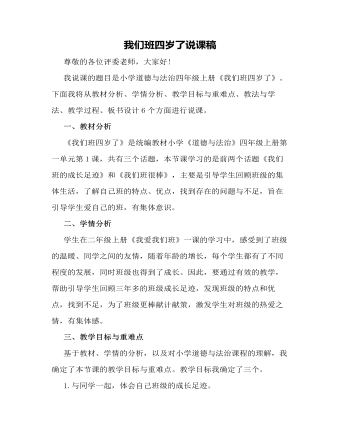
人教部编版道德与法制四年级上册我们班四岁了说课稿
然后,针对这些问题与不足,教师引导学生出主意、想办法,一一找出解决它们的金点子,板贴:金点子设计意图:引导学生找到班级的不足,为了班级更棒献计献策,激发学生对班级的热爱之情,有集体感。环节三:课堂小结,内化提升学生谈一谈学习本节课的收获,教师相机引导。设计意图:梳理总结,体验收获与成功的喜悦,内化提升学生的认识与情感。环节四:布置作业,课外延伸今后的学习生活中,为了自己班越来越棒不断努力。设计意图:将课堂所学延伸到学生的日常生活中,有利于落实行为实践。六、板书设计为了突出重点,让学生整体上感知本节课的主要内容,我将以思维导图的形式设计板书:在黑板中上方的中间位置是课题《我们班四岁了》,下面是:与班级共成长,自己班的优点,自己班的问题与不足,板贴的相应的金点子。
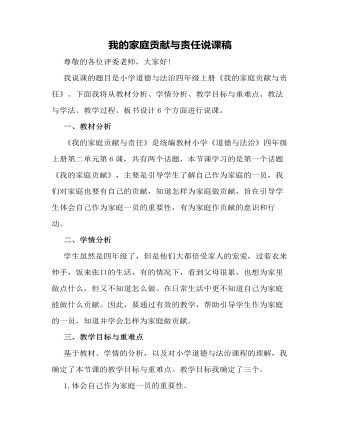
人教部编版道德与法制四年级上册我的家庭贡献与责任说课稿
活动三:用自己的创意和行动为家庭作贡献学生阅读教材第44页,看看图中的创意员为家庭出了哪些“好点子”,再想想自己家是不是也缺少些什么。然后,小组合作出主意,为了让每一个同学家更好,针对缺少的东西,想一些“好点子”。再全班展示交流,教师进行总结评价。板书:自己的创意和行动。设计意图:引导学生在讨论交流的过程中,给家里出一些“好点子”,做一些力所能及的事。环节三:课堂小结,内化提升学生谈一谈学习本节课的收获,教师相机引导。设计意图:梳理总结,体验收获与成功的喜悦,内化提升学生的认识与情感。环节四:布置作业,课外延伸生活中,多为家里做力所能及的事,为家庭做贡献。设计意图:将课堂所学延伸到学生的日常生活中,有利于落实行为实践。
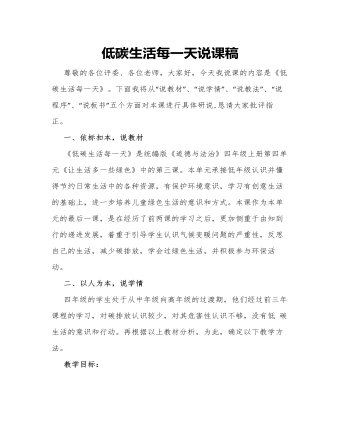
人教部编版道德与法制四年级上册低碳生活每一天说课稿
①看,好几张都是关于汽车尾气的图片。那一辆普通轿车会排放多少温室气体呢?②小结:同学们,现代化的交通工具给我们带来便利的同时,也在大量制造二氧化碳,带来全球变暖,最终给我们人类带来伤害。预设(2):工厂废气小结:工厂生产我们所需物品的同时,也在制造温室气体,使得全球变暖。预设(3):燃烧垃圾、燃烧秸秆预设(4):空调外机等电器①学生介绍②你们想过吗?空调这些家电在投入使用的时候就会间接产生温室气体。③小结:人类的很多活动都在大量排放温室气体,导致全球气候变暖。预设(5):过度砍伐①这张特殊的图片,是谁收集的?你是怎么想的?②小结:大量砍伐森林减少了对温室气体的吸收。我们来看看全球森林面积的现状。③同学们,看了介绍,你最大的感触是什么?3. 小结:“温室气体”排放以及其他人为因素已成为自20 世纪中期以来气候变暖的主要原因。
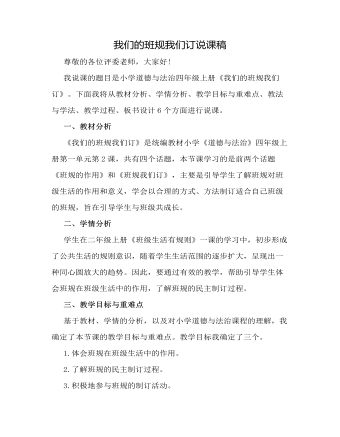
人教部编版道德与法制四年级上册我们的班规我们订说课稿
学生在二年级的时候,就有了制订自己班级规则的体验,在此基础上,学生阅读教材第10页和第11页的图文资料,看看应当怎样制订班规。接着,学生小组合作,找到合理制订班规的程序、方法,再全班汇报交流,教师相机引导。然后,根据本班的具体情况,由教师带领同学们一起讨论,制订适合自己班级的一些班规。板书:自己班的班规。设计意图:引导学生了解合理制订班规的合理方法,并一起制订自己班的班规。环节三:课堂小结,内化提升学生谈一谈学习本节课的收获,教师相机引导。设计意图:梳理总结,体验收获与成功的喜悦,内化提升学生的认识与情感。环节四:布置作业,课外延伸在今后的学习生活中,要自觉遵守自己制订的班规。设计意图:将课堂所学延伸到学生的日常生活中,有利于落实行为实践。
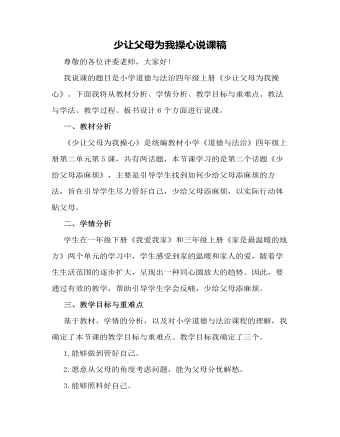
人教部编版道德与法制四年级上册少让父母为我操心说课稿
学生参考教材第31页我们能做得更好的四个方面,结合自己曾经的经验,小组讨论交流,我们尽自己所能,还可以在哪些方面做得更好,让父母少为我们操心,全班汇报交流,教师相机引导,板书:尽自己所能能做得更好的事情。设计意图:引导学生尽自己所能,在生活中做得更好,让父母少为我们操心。环节三:课堂小结,内化提升学生谈一谈学习本节课的收获,教师相机引导。设计意图:梳理总结,体验收获与成功的喜悦,内化提升学生的认识与情感。环节四:布置作业,课外延伸生活中,把能够做得更好的设想变成实际行动。设计意图:将课堂所学延伸到学生的日常生活中,有利于落实行为实践。六、板书设计为了突出重点,让学生整体上感知本节课的主要内容,我将以思维导图的形式设计板书:在黑板中上方的中间位置是课题《少让父母为我们操心》,下面是:管好自己就是为父母分担,多为父母着想,尽自己所能能做得更好的事情。
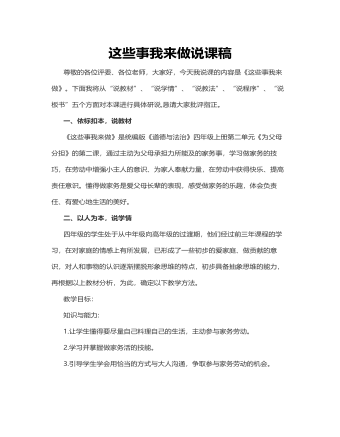
人教部编版道德与法制四年级上册这些事我来做说课稿
(6)教师小结:家务劳动好处多!通过讨论,大家都觉得作为家中的小成员,应为父母分担家务活,应力所能及主动承担家务劳动,老师为你们点赞!设计意图:这篇日记为学生提供了正面典型事例,借助榜样的作用,让学生明白作为家中的小成员,应该主动做些力所能及的家务事,替家长分担。利用教材选取的学生生活画面,针对部分学生不愿意做家务的一些主观原因,引导学生反思自己的生活,辨析他人的观点,旨在让学生理性思考做家务的意义与价值,懂得自己也是家里的小成员,不能只管好自己的事情,也应该合理安排时间为家庭出力,为父母分担,做个愿意主动承担家务劳动的好孩子。(四)、不让做,怎么办1. 组织学生讨论不做家务的其他原因。2. 教师小结:有时候并不是自己不愿意做家务,而是大人不让做。下节课的学习将一起讨论面对这样的情况该怎么办。
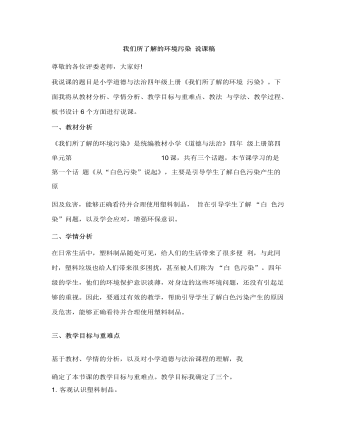
人教部编版道德与法制四年级上册我们所了解的环境污染说课稿
首先,学生阅读教材第74 页,教师引导学生交流:塑料垃圾危害这么大,我们能完全不使用塑料制品吗?如果完全不使用塑料制品, 我们的生活会变成怎样呢?生活中我们离不开塑料制品,那要怎样合 理使用呢?板书: 减少塑料袋的使用量,尽量使用塑料制品的替代品。然后, 结合课前调查和收集到的有关塑料制品的替代品,先小组讨论交流:在生活中有哪些塑料制品的替代品呢?再全班汇报交流, 教师相机引导。设计意图:引导学生了解生活离不开塑料制品,但要合理使用, 减少塑料袋的使用量,尽量使用塑料制品的替代品。环节三:课堂小结,内化提升 学生谈一谈学习本节课的收获,教师相机引导。 设计意图:梳理总结,体验收获与成功的喜悦,内化提升学生的认识与情感。
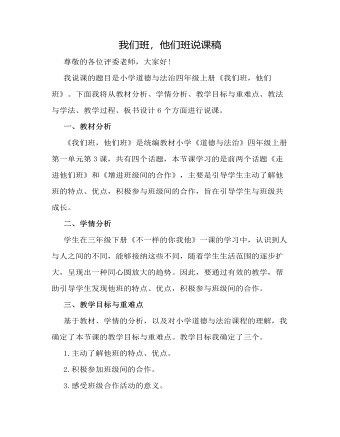
人教部编版道德与法制四年级上册我们班他们班说课稿
在上面两个活动的基础上,教师引导学生交流:你认为开展这类班级合作活动有什么意义?大家可以从中收获什么?板书:与班级共成长。设计意图:引导学生感受并认识班级间合作的意义。环节三:课堂小结,内化提升学生谈一谈学习本节课的收获,教师相机引导。设计意图:梳理总结,体验收获与成功的喜悦,内化提升学生的认识与情感。环节四:布置作业,课外延伸今后的学校生活中,积极地参与班级间的合作。设计意图:将课堂所学延伸到学生的日常生活中,有利于落实行为实践。六、板书设计为了突出重点,让学生整体上感知本节课的主要内容,我将以思维导图的形式设计板书:在黑板中上方的中间位置是课题《我们班,他们班》,下面是:班级的各种特点,积极参与班级间的合作,与班级共成长
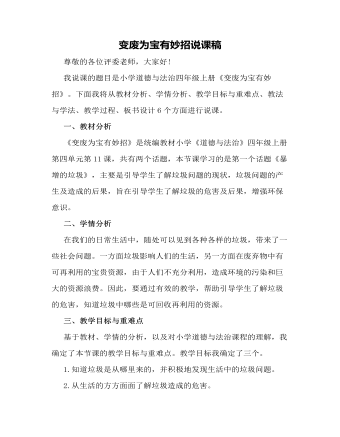
人教部编版道德与法制四年级上册变废为宝有妙招说课稿
一、教材分析《变废为宝有妙招》是统编教材小学《道德与法治》四年级上册第四单元第11课,共有两个话题,本节课学习的是第一个话题《暴增的垃圾》,主要是引导学生了解垃圾问题的现状,垃圾问题的产生及造成的后果,旨在引导学生了解垃圾的危害及后果,增强环保意识。二、学情分析在我们的日常生活中,随处可以见到各种各样的垃圾,带来了一些社会问题。一方面垃圾影响人们的生活,另一方面在废弃物中有可再利用的宝贵资源,由于人们不充分利用,造成环境的污染和巨大的资源浪费。因此,要通过有效的教学,帮助引导学生了解垃圾的危害,知道垃圾中哪些是可回收再利用的资源。三、教学目标与重难点基于教材、学情的分析,以及对小学道德与法治课程的理解,我确定了本节课的教学目标与重难点。教学目标我确定了三个。1.知道垃圾是从哪里来的,并积极地发现生活中的垃圾问题。

人教部编版道德与法制四年级上册健康看电视说课稿
首先,学生观察板书中学生喜爱看的电视节目,教师引导学生说说哪些节目是适合我们看的。板书:内容健康。然后,教师用多媒体播放医生叔叔对于小学生看电视的忠告,再结合上一个活动看电视对身心的伤害,学生在小组内讨论交流健康看电视的“金点子”,再全班交流,教师引导学生说说生活中怎样做到健康地看电视。板书:保护视力,时间合理等。设计意图:引导学生学会选择电视提供给我们的信息,在讨论交流的过程中,找到健康看电视的一些“金点子”,反思并调整自己看电视的行为。环节三:课堂小结,内化提升学生谈一谈学习本节课的收获,教师相机引导。设计意图:梳理总结,体验收获与成功的喜悦,内化提升学生的认识与情感。环节四:布置作业,课外延伸生活中,做到健康地看电视。设计意图:将课堂所学延伸到学生的日常生活中,有利于落实行为实践。